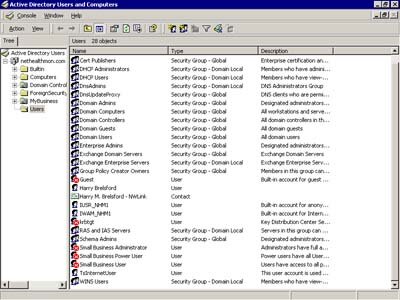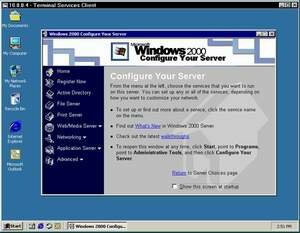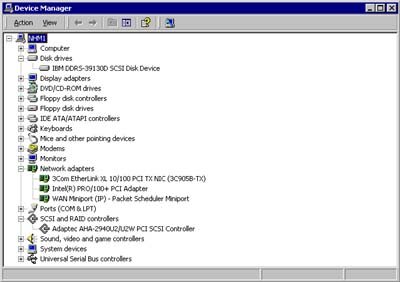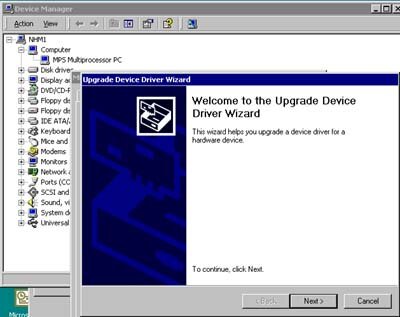|
1/15/2001 -- Windows 2000 is now a rambunctious toddler as it celebrates its first birthday. I have ten reasons why you should join the celebration and not only purchase but also deploy Win2K in your organization today. Interestingly, these reasons are not necessarily in the same order that I listed one year ago introducing Win2K to the certification community in MCP Magazine (see "Amazing Feast! Windows 2000 on the Table" in the Dec. 1999 issue). However, many of the reasons supporting the deployment of Win2K last year are still valid today and will retain validity tomorrow. This month I revisit the top ten reasons for deploying Win2K, one year later. Let's get started.
1. Business Applications
Topping my list is an old-fashioned and somewhat staid topic from any "Introduction to Computers" course: determine your business needs first. Business needs typically manifest themselves in expressions of business applications that need to be deployed. How can this be, you ask? Am I not departing from my primary thesis about tooting the Win2K horn? Stick with me for a paragraph or two and I'll explain.
As a practicing MCSE consultant, I'm constantly reminded that the "theory" I learned in management information systems courses in college has become reality. In the old days, when knights were bold and Microsoft blue cards held all the gold, information system purchase decisions were made based on the needs of the business. These needs were often identified after extensive analysis performed by a consultant. Initially, little regard was given to the operating system or vendor (although there was an important need to go through vendor qualification steps as well).
Then somewhere along the way, many of us (including this MCSE) became more interested in the operating system's features and functions than the end results desired from a business from its line-of-business application. From the late 1980s through late 1990s, it was easy to get caught up in the war of the day including Microsoft versus Apple, or Windows NT versus NetWare. Our customers suffered, to say the least.
Along came Win2K with some mysterious powers and a revamped MCSE program that focused on business needs analysis. Suddenly, business needs are back in fashion. I'm starting to see a couple of things in the Win2K business application area. First, more line-of-business applications are being launched with the Win2K seal of approval, meaning the software has been enhanced to exploit Win2K features and functions. More importantly, business applications are starting to integrate with Active Directory by modifying the schema (database structure). This is done in several ways including the Active Directory Services Interface, an application programming interface (API).
Bottom line is that your application vendor will drive you towards implementing Win2K. That is, as more line-of-business applications become Win2K compliant, support for older editions of your business software will dry up.
Simply stated, the business applications that are Win2K will do more cool stuff, making this the most compelling reason to embrace Win2K today.
2. More Stability
In my "calling it like it is" modus operandi this month, I can attest that I'm having success introducing Win2K Server to my customers based on its increased stability. Blue screens of death (BSOD) are much fewer and far between. It's hard to recall a BSOD since the commercial release of Win2K (I did see a couple back in the beta test period in 1999, but all is fair in a pre-release version). I think this is one of the best reasons to implement Win2K.
3. Fewer Reboots
Closely related to the above point, but coming in third in my Win2K top ten list, is fewer reboots. I don't have to come into the office late at night to perform a reboot or disrupt people because I've absolutely got to reboot at mid-day (much like I found myself doing back in the Windows NT days - ouch!).
4. Active Directory
Slipping down to fourth from first (from my top 10 list last year) is the much-promoted Active Directory. Don't get me wrong, I'm a big fan of AD. I like the replication capabilities so my critical "database" of user settings and system configuration information is stored in more than one place in a multiple domain controller (DC) scenario. And I like that the physical limitations on domains have been removed (allowing my clients to typically operate with a single domain). Goodbye complex trust relationships and hello organizational units (OUs) which have largely replaced the need for many domains (especially resource domains).
But accolades aside, the momentum for AD is still in its infancy. AD is complex and people are still learning it and thinking of ways to use it. My prediction? Look for AD (see Figure 1, below) to return to the top of my list next year when it's absolutely the rage in the MCSE community!

|
Figure 1. Active Directory Users and Computers snap-in is one of the
most popular ways to interact with Active Directory. (Click image to view
larger version.) |
5. Group Policy
Something that is moving up and gaining serious momentum is Group Policy. Group Policy is the ability to automate the administration and configuration of your Win2K network by performing several functions including Win2K Professional policy-based configuration (e.g. the ability to lock down a workstation), install software and manage user settings. It is surprisingly powerful and very much a welcome friend. Since Group Policy only works in the homogenous Win2K networks (the client workstation must be running Win2K Professional), I believe that Group Policy (shown in Figure 2, below) is the "killer application" that is driving much of the success of Win2K Professional, thus earning a place in the top half of my list this year.

|
| Figure 2. Looking at Group Policy and its many capabilities. |
6. Terminal Services
Coming on strong in Win2K is Terminal Services. Terminal Services is one of those areas where a picture is worth a thousand words. In Figure 3, below, you can see that the inside window is a Terminal Services session where the user runs a full Win2K session remotely.

|
Figure 3. Observe a Terminal Services session in the inside window.
(Click image to view larger version.) |
This is known as a remote host approach, where only the delta screen changes are passed on, not all of the network traffic. This allows the Terminal Services user to enjoy a fast computing session without necessarily being present and attached to the network (inside of the four walls at the office). There are several popular uses for Terminal Services including the ability to work from remote locations over the Internet and enjoy full network capabilities at seemingly high-speeds and the ability to use thin clients such as the WinTerm clients (basic monitor, keyboard and mouse without a CPU box). My favorite use of Terminal Services is the ability to perform remote administration on my client's servers from many miles away!
7. Hardware Support
A favorite, worthy of the top ten list, is the increased hardware support found in Win2K. I'm seeing this on several fronts. Starting with the initial installation of Win2K Server, I'm now longer hitting the F6 key nearly as much right after the first setup disk runs in character-based mode to add unsupported RAID and SCSI controller drivers. That is a joy as Win2K Server supports many more controller cards than Windows NT.
Equally important, the automatic and accurate device detection has become a fast friend of mine. This means that you don't need to run some convoluted setup program on a manufacturer's drivers diskette followed by a reboot or three.
The Hardware Manager in Win2K (see Figure 4, below) is very much like the Hardware Manager found in Windows ME/9x and it's a very welcome addition from the Windows NT days.

|
Figure 4. Hail to Hardware Manager in Win2K. Truly this is another cool
tool. (Click image to view larger version.) |
8. VPN Support
Not that you couldn't do this before, but the ability to create a virtual private network (VPN) connection is not only easier between locations with Win2K but I'm finding it's much more stable. I now have clients running mission critical network connections between offices via a VPN connection in Win2K. Cool!
Caution: When you configure the server-side VPN capabilities using the configuration wizard in Routing and Remote Access Service (RRAS), note that this wizard believes the server will only be used for VPN activity when it comes to remote communication. It has a nasty way of shutting down other port openings you might need to Microsoft Internet Security and Acceleration (ISA) Server. Ouch!
9. Wizards
I've always been a fool over a pretty face and thus I can express my endearing love for the wizards in Win2K. Each time I turn the corner in Win2K, I'm seduced by some sexy wizard or another. Can Win2K be configured without wizards? Yes, but I prefer the ease of administration afforded by the extensive collection of wizards in Win2K. And for that reason, wizards make my top ten list this year. Whenever possible, use the wizards! A Win2K wizard is shown in Figure 5.

|
| Figure 5. There are wizards for nearly every configuration task in Win2K! |
10. Improved Relations
My final pitch to you on implementing Win2K today: The doggoned thing just works better. As an MCSE consultant, I'm finding my client relations are improving when I implement Win2K. And with fewer late-night site visits to reboot servers, my family relationship is stronger to boot! Have you implemented Win2K yet? How has your impression changed over the past year? Post your comments below!
|

 Column Story
Column Story





